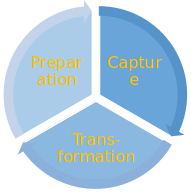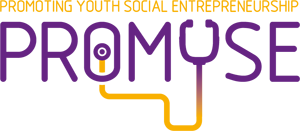-
Introduction 2
At the beginning terms used in this course will be described in the vocabulary and an introductory quiz allowing learner to identify current knowledge on Human Centered Design in service provision will be provided. Indicative time of completion of unit: 10 min.
-
VocabularyLecture1.1
-
Pre-Quiz 6 questionsQuiz1.1
-
-
What is Human Centered Design? 2
A summary of the Human Centered Design process and assumptions underlying it’s application will be presented in this unit. Indicative time of completion of unit: 5 min.
-
What is Human Centered Design?Lecture2.1
-
Case StudyLecture2.2
-
-
Immersion 4
First stage of Human Centered Design thinking will be presented in this unit. Immersion of different depth, research techniques needed at this stage will be presented. Indicative time of completion of unit: 30 min.
-
IntroductionLecture3.1
-
Preliminary ImmersionLecture3.2
-
In-Depth ImmersionLecture3.3
-
Analysis and SynthesisLecture3.4
-
Case StudyLecture3.5
-
-
Ideation 1
The purpose of this phase is to generate innovative ideas for the project theme/services being planned. To do this, the tools for synthesis created in the analysis phase are used to stimulate creativity and generate solutions that are in tune with the context of the subject in question (services planned). Indicative time of completion of unit: 10 min.
-
IdeationLecture4.1
-
-
Prototyping 2
The function of Prototyping is to aid in the validation of the ideas generated, and although it is presented as one of the last phases of Human Centered Design Thinking, it can occur throughout the project simultaneously with Immersion and Ideation. Prototyping will be presented in this unit. Indicative time of completion of unit: 10 min.
-
PrototypingLecture5.1
-
Case StudyLecture5.2
-
-
Conclusions 3
Conclusions section
-
Conclusion of courseLecture6.1
-
VideoscribeLecture6.2
-
Post-Quiz 10 questionsQuiz6.1
-
Preliminary Immersion
When beginning a project using Human Centered Design Thinking, we might not be familiar with the subject. Therefore, a Preliminary Immersion is undertaken as a way of approaching the problem. Preliminary Immersion is divided into smaller steps: Reframing, Exploratory Research and Desk Research.
Reframing is an examination of problems and issues from different perspectives and numerous angles, making it possible to find out beliefs and assumptions of the players (stakeholders) involved, to understand their thought patterns. A problem cannot be solved using the same kind of thinking that gave rise to it, so reframing must be undertaken as a first phase in generating (innovative) solutions. Reframing starts with meeting the clients, either in individual or group interviews, looking at the problem from their perspectives and defining boundaries of the project that you are planning (Vianna et al, 2012).
At first there is collection of data about beliefs and assumptions of people that will be using services – this is called Capture. Players involved are asked questions (interviewed) about possible solution/service during meetings/encounters with them, though they may also be prompted to engage in different interactive exercises to arrive at a different view of the issue. Collected data is surveyed and new perspectives added – Transformation achieved. Then Preparation is the moment when materials for impact awareness are created based on the result of the transformation, and are used to stimulate the parties to reflect. Frequently, issues that need clarification are raised, and tools for the next cycle (back to capture) are developed/chosen. Cycles of capture, transformation and preparation, can repeat themselves until the reframing objective is achieved.

The goal of all of this is to stimulate all parties involved to see the problem from different points of view, creating a new understanding of it, in order to lead to the identification of innovative paths to solve it. Process duration may vary, from a single workshop to several weeks, and process needs to be facilitated.
Also it might be needed to conduct an Exploratory Research in the field as the next step, in order to hear about the subject (problem) so it can arrive at an initial understanding of the users and stakeholders enmeshed in the context and help to define the key profiles to be looked at next, in the In-Depth Research (Vianna et al, 2012).
Exploratory Research is field research that helps to understand the context and provides input for the definition of profiles of service users, agents and environments, or phases of the life cycle of the service that will be explored through In-Depth Immersion. This is an approach to the reality of end-users and stakeholders that provides a better understanding of their demands and latent needs, so that relevant insights can be captured during the In-Depth Immersion. It is applied through participant observation – the researcher goes out into the street to observe and interact with the people involved in the project’s context. She/he seeks out places relevant to an understanding of the subject under review and the users of the service, as well as other individuals involved. All the observations are recorded or noted for further examination and usage (Vianna et al, 2012).
Desk Research might also be undertaken to discover trends on the subject in the market or area where project will be implemented. Desk Research is a search for information on the project theme using various sources (websites, books, magazines, blogs, articles, etc.). The term “desk” comes from “desktop,” and is used because most of such research currently performed is based on reliable Internet references. It is used to obtain information from sources other than the users and players directly involved in the project, mainly by identifying trends in the area and wider environment having to do with the topic in view, or related topics. It can take place at any point of a project when issues are identified that need to be taken into in greater depth, but it is especially useful at the outset to help you understand the boundaries and perspectives of the topic better.
Application: based on the project’s subject, a tree of related topics is created to initiate the research. These inputs are often obtained during the Exploratory Research and continue to grow and unfold as the researcher finds new sources and citations on subjects that may yield information relevant to the project. References are recorded. The intersection of this data with the one collected in the field during the In-Depth Immersion allows to identify patterns and areas of opportunity to be explored in subsequent phases of the project (Vianna et al, 2012).


 English
English Lietuviškai
Lietuviškai Ελληνικά
Ελληνικά Italiano
Italiano Français
Français